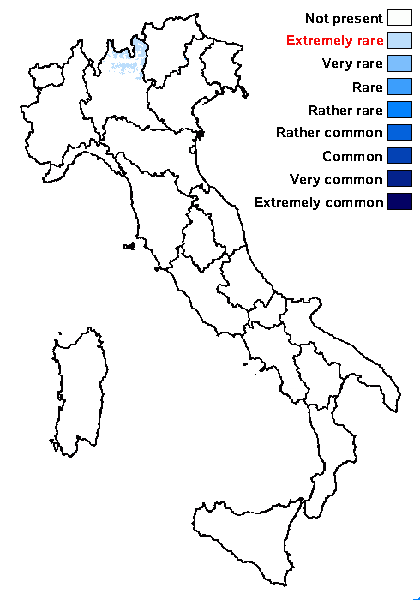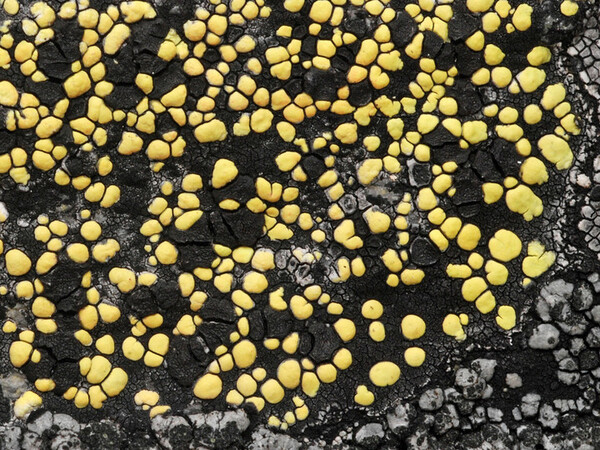Rhizocarpon intermediellum Räsänen
Feddes Rep. Spec. Nov. Regni Veg., 52: 132, 1943.
Synonyms: Rhizocarpon wulffianum Räsänen
Distribution: N - Lomb (Nascimbene & al. 2021)..
Description: Thallus crustose, episubstratic, areolate, yellowish green, forming small patches (up to 2 cm in diam.) on the thalli of other crustose lichens, developing on a black hypothallus and usually delimited by a black prothalline line. Areoles small (up to 0.8 mm wide), angular, rather thin, isolated or contiguous, flat to slightly convex, smooth to rugose. Medulla white, I+ blue. Apothecia lecideine, black, up to 0.6 mm across, angular, arising between the areoles, with a concave to flat, often gyrose disc and a thin, but persistent ad usually well-evident proper margin. Epithecium brown, K+ red or K-; hymenium colourless; paraphysoids strongly conglutinate, richly branched and anastomosing, apically clavate; hypothecium brown. Asci 8-spored, clavate, fissitunicate, with a well-developed tholus, lacking an ocular chamber, Rhizocarpon-type. Ascospores mostly 3-septate, sometimes submuriform, dark blue green in the early stages, brown at maturity, ellipsoid, 14-24 x 8-14 µm, halonate at least when young. Photobiont chlorococcoid. Spot tests: cortex K-, medulla K-, C-, KC-, P- or P+ yellow. Chemistry: cortex with rhizocarpic acid, medulla with psoromic acid or without lichen substances.Note: on basic siliceous rocks (e.g. amphibolite) and schists with low content of calcium in exposed situations, often on pebbles in wind-swept ridges, parasitic on various crustose lichens (incl. species of Bellemerea, Lecidea, Buellia sect. Melanaspicilia, Tremolecia) in the early stages of development; widespread in Europe; from the Alps there are several scattered records, but apparently the species was overlooked in some regions (incl. Italy). The species morphologically resembles Rh. norvegicum, but the ascospores are submuriform, larger (to 20 µm long), with 1-4 transverse septa and 1 incomplete longitudinal septum; the distinction from Rh. furax is also in need of critical re-evaluation.
Growth form: Crustose
Substrata: rocks
Photobiont: green algae other than Trentepohlia
Reproductive strategy: mainly sexual
paras crustose lichens
Commonnes-rarity: (info)
Alpine belt: extremely rare
Subalpine belt: extremely rare
Oromediterranean belt: absent
Montane belt: absent
Submediterranean belt: absent
Padanian area: absent
Humid submediterranean belt: absent
Humid mediterranean belt: absent
Dry mediterranean belt: absent

Predictive model
Herbarium samples
Growth form: Crustose
Substrata: rocks
Photobiont: green algae other than Trentepohlia
Reproductive strategy: mainly sexual
paras crustose lichens
Commonnes-rarity: (info)
Alpine belt: extremely rare
Subalpine belt: extremely rare
Oromediterranean belt: absent
Montane belt: absent
Submediterranean belt: absent
Padanian area: absent
Humid submediterranean belt: absent
Humid mediterranean belt: absent
Dry mediterranean belt: absent

Predictive model
| Herbarium samples |
 Index Fungorum
Index Fungorum
 GBIF
GBIF


